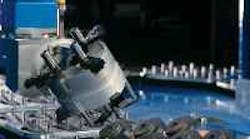When production suddenly picks up, a retrofitable gantry loader can save the day.
Retrofitable gantry-style loaders, such as those from Wes-Tech Automation Systems, handle unexpected, high-volume jobs.
Wes-Tech loaders are not completely dedicated to one job. Components such as this shaft gripper and chucking gripper are interchangeable for a number of jobs.
No one can predict the future. So when jobshops purchase machine tools, they mainly base their decisions on current workload. That's why a shop might decide against adding options such as an automated part-loading package, figuring the shop's manual labor can handle the machine's loading. However, when unexpected, high-volume jobs start coming in, these shops can quickly find themselves unable to keep up.
For these situations, shops can turn to gantry-style loaders that are retrofitable to existing machine tools. Wes-Tech Automation Systems manufactures and installs such loaders. The Lincolnshire, Ill., company retrofits about 85% of its turning center loaders to older, existing machines. In most cases, shops call with emergency situations that require immediate integration of automated part loading. The challenge is to accomplish this with little disruption to the customer's production flow.
Made to retrofit
Wes-Tech conducts a 24-hr runoff prior to shipping its gantry loaders. In testing, the units load and unload a customer's actual part into a simulation of the intended machine tool. At their destinations, loaders need only mounting, leveling, and integrating.
"Because the loader is gantry-style," says James Gondeck of Wes-Tech, "it never blocks the front of the machine tool." Other loading systems, he adds, can obstruct the front of a turning machine, making it difficult for manual operation. Since Wes-Tech's gantry system is completely above the machine, operators can easily get in for manual runs, insert changes, tooling offset adjustments, and so forth.
During integration, the machine-tool program does not change. Loaders use signals inserted after the machining process that provide communication between the machine's control and the loader's control. Typical load/unload times are approximately 12 sec. Also, the use of standard, interchangeable components makes retrofitting painless.
Modular designs let Wes-Tech customize its loaders because not every shop loads sawed blanks. For instance, a shaft gripper is easily interchanged for a chucking gripper, and the standard gripper can do the work of several grippers by handling diameters up to 6.7 in. with a single-screw adjustment. Wes-Tech makes loaders that can accommodate almost any part up to 150 lb.
The company determines which system to implement based on the customer's average raw part weight. Its model TCL 210, for instance, moves two 10-lb parts, its TCL 220 handles two 20-lb parts, its TCL240 tackles two 40-lb parts, and on up to the TCL 270.










